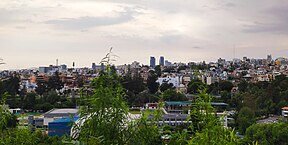
Back Arequipa Afrikaans Arequipa AN Arequipa ANG أريكيبا Arabic اريكيبا ARZ Ariqipa Aymara Arekipa Azerbaijani Арэкіпа (горад) Byelorussian Арэкіпа (горад) BE-X-OLD Арекипа Bulgarian
Arequipa | |
|---|---|
Region capital | |
| City of Arequipa | |
Partial view of the city and Chachani Campiña Paisajista Neighbourhood and City Center Skyline of Arequipa | |
| Nickname(s): La Ciudad Blanca (The White City), León del Sur (Lion of the South) | |
| Anthem: Himno Arequipeño | |
| Coordinates: 16°24′S 71°32′W / 16.400°S 71.533°W | |
| Country | Peru |
| Region | Arequipa |
| Province | Arequipa |
| Established | 15 August 1540 |
| Founded by | Garcí Manuel de Carbajal |
| Government | |
| • Mayor | Víctor Hugo Rivera (2023–2026) |
| Area | |
| • Region capital | 69 km2 (27 sq mi) |
| • Metro | 2,923.53 km2 (1,128.78 sq mi) |
| Elevation | 2,335 m (7,661 ft) |
| Population (2017) | |
| • Region capital | 1,008,290 |
| • Estimate () | 1,214,290 |
| • Density | 15,000/km2 (38,000/sq mi) |
| • Metro | 1,034,736 |
| Demonym | Arequipeño |
| GDP (PPP, constant 2015 values) | |
| • Year | 2023 |
| • Total | $12.8 billion[1] |
| Time zone | UTC-5 (PET) |
| • Summer (DST) | UTC−5 (PET) |
| Postal code | 040 |
| Area code | 54 |
| Website | www |
| Official name | Historical Centre of the City of Arequipa |
| Type | Cultural |
| Criteria | i, iv |
| Designated | 2000 (24th session) |
| Reference no. | 1016 |
| Region | Latin America and Caribbean |
Arequipa (Spanish pronunciation: [aɾeˈkipa]; Aymara and Quechua: Ariqipa), also known by its nicknames of Ciudad Blanca (Spanish for "White City") and León del Sur (Spanish for "Lion of the South"),[2] is a city in Peru and the capital of the eponymous province and department. It is the seat of the Constitutional Court of Peru and often dubbed the "legal capital of Peru".[3] It is the second most populated city in Peru, after the capital Lima, with an urban population of 1,296,278 inhabitants according to the 2017 national census.[citation needed]
Its metropolitan area integrates twenty-one districts, including the foundational central area, which it is the seat of the city government. The city had a nominal GDP of US$9,445 million, equivalent to US$10,277 per capita (US$18,610 per capita PPP) in 2015, making Arequipa the city with the second-highest economic activity in Peru.[4]
Arequipa is also an important industrial and commercial center of Peru,[5] and is considered as the second industrial city of the country. Within its industrial activity the manufactured products and the textile production of wool of camelids. The town maintains close commercial links with Chile, Bolivia, and Brazil and with the cities connected by the South trainway, as well as with the port of Matarani.[6]
The city was founded on 15 August 1540, under the name of "Beautiful Villa of Our Lady of the Assumption" in the name of Marquis Francisco Pizarro. On 22 September 1541, the monarch Carlos V ordered that it should be called the "City of Arequipa". During the viceregal period, it acquired importance for its outstanding economic role,[5] and is characterized by the fidelismo towards the Spanish Crown,[7] which honored Arequipa with titles such as "Very Noble and Very Loyal".[8] In the Republican history of Peru, the city has been the focus of popular, civic and democratic rebellions. It has also been the cradle of notable intellectual, political and religious figures.[9] In the Republican era, it was awarded the title of "Heroic city of the free people of Arequipa".[10]
Its historical center extends over an area of 332 hectares[11] and has been declared a UNESCO World Heritage Site.[12] Historical heritage and monumental that it houses and its diverse scenic and cultural spaces turn it into a host city of national and international tourism, in its historical center it highlights the religious architecture viceregal and republican product of mixture of Spanish and autochthonous characteristics,[13] that constituted an own stylistic school called "Arequipeña School"[14] whose influence arrived in Potosí (Bolivia).[15][16]
- ^ "TelluBase—Peru Fact Sheet (Tellusant Public Service Series)" (PDF). Tellusant. Retrieved 11 January 2024.
- ^ Vargas Gutiérrez, José Luis (2002). Arequipa, en búsqueda del León perdido (in Spanish). Vol. 2. Paradigma. p. 1.
- ^ Official Journal El Peruano (2010). Legal Information System (PDF). p. 96.
- ^ "Urban world: What's next?". McKinsey Global Institute. McKinsey & Company. October 2016.
- ^ a b Chanfreau, p. 40
- ^ Mincetur. «Export Investment Guide», p. 17
- ^ Linares Málaga, p. 115
- ^ (Barriga 1940, p. 133)
- ^ Provincial Municipality of Arequipa. «Normative Compendium of the Historic Center of Arequipa», p. 63
- ^ (Neira et al. 1990, p. 438)
- ^ Provincial Municipality of Arequipa. «Normative Compendium of the Historic Center of Arequipa», p. 80
- ^ UNESCO (2000). "Historical Center of the City of Arequipa".
- ^ Technical Office of the Historical Center and Monumental Zone of Arequipa (MPA – OTCHA) (2002). Final Normative Compendium of the Historic Center of Arequipa (PDF) (Report). p. 2. Archived from the original (PDF) on 7 November 2012.
- ^ "Endesa ilumina la iglesia barroca de la Compañía". Infolatam. 6 June 2007. Archived from the original on 20 November 2008. Retrieved 4 August 2009.
- ^ Municipalidad Provincial de Arequipa. «Compendio normativo del Centro Histórico de Arequipa», p. 6
© MMXXIII Rich X Search. We shall prevail. All rights reserved. Rich X Search











